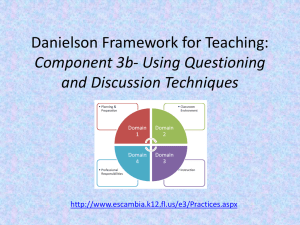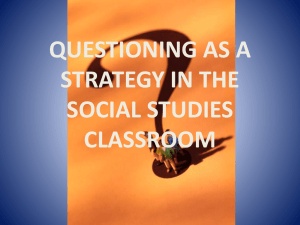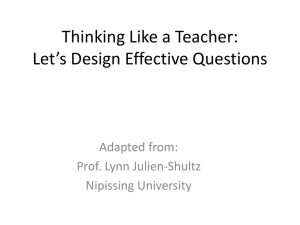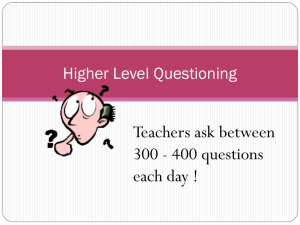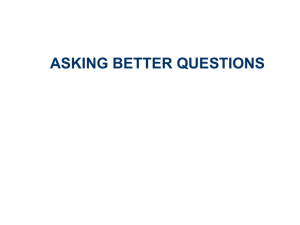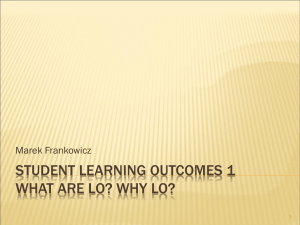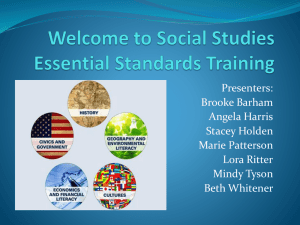2009-03-24 PD
advertisement
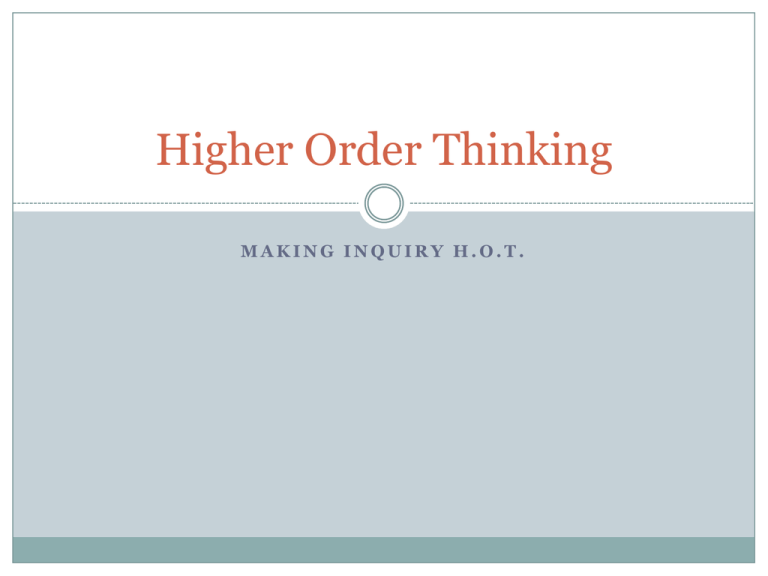
Higher Order Thinking MAKING INQUIRY H.O.T. Grounding LINE UP Academic Vocabulary Revisiting What are some things you hope students will gain from a focus on academic vocabulary? What are some strategies you are using to teach academic vocabulary? Since the last PD, what are some of the challenges you’ve faced in teaching academic vocabulary? Today’s Outcomes and Objectives Outcomes Objectives Increased awareness Engage in using around inquiry and higher order thinking skills to increase rigor in all content areas Building connections between Bloom’s, Marzano, and Costa Bloom’s/Costa’s strategies Engage and experience writing higher order thinking skills questions using Bloom’s or Costa’s Define what Bloom’s/Costa looks like in the different content areas The Inquiry Method “The goal of the inquiry method is to help students become more aware of the range of problem-solving and critical-thinking behaviors available to them and to improve their ability to apply these behaviors when they are confronted with a problem to which they have no ready answer.” Art Costa When students learn the taxonomy of questions this gives them a variety of ways to think about a problem in different ways. Historically, state and national surveys indicate that approximately 80% of the questions K-12th Why Use Inquiry as a Teaching Methodology? Standardized tests have an grade students are increasing focus on analysis, exposed to are lower- synthesis and evaluation. level questions In college this trend reverses, and students are asked to deal primarily with high-level critical questions With high stakes testing, inquiry strategies become critical aspects of classroom instruction. Marzano Vocabulary Game In your table groups, work together to categorize the different cognitive words into the different levels of Bloom’s Taxonomy on your poster paper. The first team to categorize all of their words correctly will win a prize! Bloom’s Taxonomy Creating construct, create, design, (Evaluate) Evaluating defend, judge, value (Synthesis) Analyzing compare, contrast, criticize (Analyze) Applying interpret, illustrate, solve (Application) Understanding describe, discuss, explain (Comprehension) Remembering (Knowledge) define, duplicate, list Bloom’s Taxonomy Bloom’s Taxonomy is a multi-tiered model of classifying thinking by six cognitive levels of complexity. First created in the 1950’s, Bloom’s Taxonomy was revised in the 1990’s in an attempt to make it more relevant for 21st century students and teachers. Old Version Revised Version Evaluate Creating Synthesis Evaluating Analysis Analyzing Application Applying Comprehension Understanding Knowledge Remembering Nouns Verbs Bloom’s Taxonomy Creating: Can the student create new product or point of view? assemble, construct, create, design, Evaluating: Can the student justify a appraise, argue, defend, judge, stand or decision? select, support, value, evaluate Analyzing: Can the student distinguish between the different parts? appraise, compare, contrast, criticize, differentiate, discriminate, distinguish, examine, experiment, question, test Applying: Can the student use the choose, demonstrate, dramatize, employ, illustrate, interpret, operate, schedule, sketch, solve, use, write classify, describe, discuss, explain, identify, locate, recognize, report, select, translate, paraphrase information in a new way? Understanding: Can the student explain ideas or concepts? Remembering: Can the student recall or remember the information? develop, formulate, write define, duplicate, list, memorize, recall, repeat, reproduce state Costa’s Levels of Questioning LEVEL 1 – Book Only The answer can be found in the text (either directly or indirectly). Texts include books, lectures, or straight from the horse’s mouth. This type of question is very concrete and pertains only to the text; it asks for facts about what has been heard or read. Information is recalled in the exact manner/form it was heard. Costa’s Levels of Questioning LEVEL 2 - Book & Brain The answer can be inferred from the text. This type question, although more abstract than a level one question, still relies on the facts. With a level two question, the brain has to use the facts. Answers combine information in a new way. Information can be broken down into parts; it involves examining in detail, analyzing motives or causes, making inferences, finding information to support generalizations or decision-making. Costa’s Levels of Questioning LEVEL 3 - Brain Only The answer goes beyond the text. This type of question is abstract and does not pertain directly to the text. These questions ask that judgments be made from information. They also give opinions about issues, judge the validity of ideas or other products and justify opinions and ideas. Costa’s Levels of Questioning Level One: Defining Describing Identifying Listing Scanning Reciting Observing Naming Level Two: Analyzing Comparing Grouping Contrasting Inferring Sequencing Synthesizing Imagining Level Evaluating Three Hypothesizing Judging Speculating Predicting : Applying a principle •What is the definition of “lunar eclipse?” (definition) •How can we express the equation 2x(4-5y)=3y-26 in three ways (list) •What states seceded from the Union to form the Confederacy (identification) •How does “The Road Not Taken” (Frost) begin? (recitation) •In Native Son how does Bigger Thomas’ violence against his gang members reveal a deeply-rooted insecurity and fear of people? (analysis) •How does the term “Manifest Destiny” capture the essence of western expansion in the United States? (synthesis) •If the moon is full Aug.17, July 18, and June 19, when will it be full in April? (inference) •Using the principle of commutative property, how can we find out the number of apple trees in an orchard having 15 rows, 5 trees each? (application) •Which of the characters in Great Expectations suffered the most? (judgment) •Without the idea of “Manifest Destiny” what might the United States look like today? (speculation) Write Around E a c h i n d i v i d u a l i n y o u r g r o u p o f f i v e w i l l h a v e a p i c t u r e T h e w r i t e a r o u n d p r o c e s s b e g i n s w i t h e a c h p e r s o n w r i t i n g a higher order thinking (h.o.t.) question on their paper A f t e r a c o u p l e m i n u t e s , t h e f a c i l i t a t o r w i l l a s k y o u t o p a s s your paper to the person sitting on your right Y o u w i l l t h e n a d d a n o t h e r h . o . t q u e s t i o n t o t h e p a p e r passed to you R e p e a t t h i s p r o c e s s u n t i l y o u r e c e i v e y o u r o w n p a p e r b a c k and have a dialogue around the types of questions you see added to your paper Stir the Classroom • In groups of four, make a circle around the room • Number off 1-4 within your group • Discuss the questions provided with your group. • When a number is drawn, that person will move to the next group and share the thinking of his/her group and hear the new group’s thinking. Stir the Classroom • What are some similarities and differences that you are noticing between Bloom’s Taxonomy and Costa’s Levels of Questioning? Stir the Classroom • What might be some questions you are having about either Bloom’s Taxonomy or Costa’s Levels of Questioning? Stir the Classroom • How might using either Bloom’s Taxonomy or Costa’s Levels of Questioning look in your class or content area? Give One, Get One •N o w t h a t y o u ’ v e h a d a n o p p o r t u n i t y t o e x p e r i e n c e a n d r e f l e c t w ith your colleagues around Higher Order Thinking Skills and B l oom’s a nd C os ta ’s , fi nd a c ol l e a gue i n your s a me de pa r tme nt and share one strategy or w ay in w hich you plan to incorporate these skills into your class. •O n c e y o u ’ v e g a v e o n e a n d g o t o n e f r o m t h a t f i r s t c o l l e a g u e , f i n d another colleague in your department and repeat the process. •C o n t i n u e u n t i l y o u s e e t h e t i m e o u t h a n d s i g n a l t o c o m e b a c k together H.O.T Resources Art Costa’s website for Habits of Mind http://www.habits-ofmind.net/ Emerging Perspectives on Learning, Teaching, and Technology Find more about Bloom’s Taxonomy and other inquiry based learning http://projects.coe.uga. edu/epltt/index.php?tit le=Main_Page Find Power Point presentations posted online at www.slideshare.net like this one on questioning practices http://www.slideshare.net/rmakely/questioni ng-practices-and-strategies eBest ICT Cluster – Although based in New Zealand, this website offers many teaching and learning resources around inquiry learning, including Bloom’s and different levels of questioning.http://centre4.interact.ac.nz/spa ces/space.php?space_key=13303 Concept to Classroom - Website of online workshops for teachers around various topics including inquiry based learning and using WebQuest with students http://www.thirteen.org/edonline/concept2cl ass/index.html Next Steps On Tuesday, March 31st departments will meet for Common Planning Time Depending on your department’s schedule, you might want to discuss the strategies presented today and student work related to higher order thinking skills and levels of questioning On Tuesday, April 14th, we will have a PD around connecting academic vocabulary and higher order thinking skills Pluses and Wishes Feedback for Next Time Pluses and Wishes Pluses – Things you liked and would like to see continued Wishes – Things you would like to see implemented for next time Professional Development Survey Go to the Stevenson MS website (www.rlstevenson.net) and click on “PD Evaluation Form” under the “Links” section
